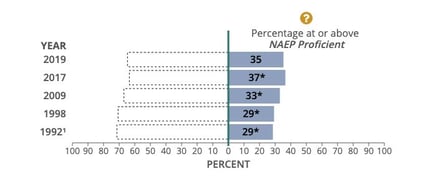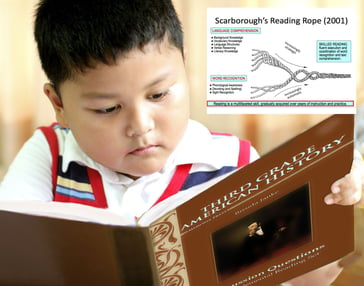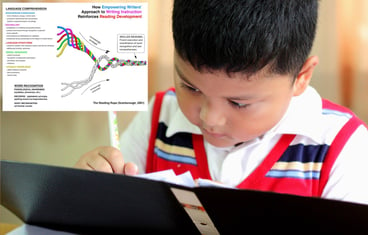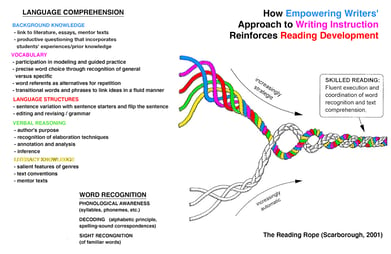Recommended Reading | Writing Instruction | writing-reading connection | science of reading
Writing’s Role in the Science of Reading
What is writing’s role in the Science of Reading?
The now famous Reading Rope illustrates the many strands that are woven into skilled reading, which can be broken into two areas of instruction, Language Comprehension and Word Recognition.
Writing plays a significant role in building strategic reading skills: literacy knowledge, vocabulary, and more, all of which can be taught through explicit, effective writing instruction.
Our team of educators has created Writing’s Role in the Science of Reading to dive deeper into these topics, providing a myriad of information to support your effective writing instruction!
Writing's Role in the Science of Reading
While the debate rages on regarding effective reading instruction, science is challenging many of the long held beliefs of best practices in the realm of reading. It is hard to ignore the latest results of the nation’s report card on reading in this country. Currently in the United States, only about one-third of our fourth graders are reading at grade level with accuracy, fluency, and understanding. (NAEP 2019) When looking at the performance of eighth and twelfth graders we see that number remains mostly unchanged.

Within the latest research and renewed discussions about the Science of Reading it is equally noteworthy to acknowledge the role of explicit writing instruction in the equation. Consider the now famous Reading Rope created by Hollis Scarborough, senior scientist at Haskins Laboratories, a leading researcher of early language development and its connection to later literacy. The Reading Rope illustrates the many strands that are woven into skilled reading. Those strands can be broken into two areas of instruction - Language Comprehension and Word Recognition. As Scarborough depicts, language comprehension leads to increasingly more strategic reading. Of those strategic reading skills, literacy knowledge, vocabulary, background knowledge of facts and concepts can be explicitly taught through writing instruction. Both language structure and verbal reasoning can be found in a solid grammar and mechanics approach.
Additionally, as noted by Dr. Shanahan, Literacy Expert (Shanahan, Timothy “What is the Science of Reading” May 29, 2019 ) “Phonics is certainly an important part of the science of reading, but it’s not the whole thing. Any real “science of reading” would include all the methods or approaches that have been found, through research, to give kids a learning advantage in reading. That means oral reading fluency instruction should be part of the science of reading. And, vocabulary and morphology teaching, too. There are also a number of instructional approaches that have been found to boost reading comprehension by teaching thinking strategies or enhancing written language performance (e.g., cohesion, sentence combining/reducing). And, guiding kids to write about text is scientific, as well.”
This solid connection between reading and writing is one that helps to serve two purposes. While addressing the strands of language comprehension through writing you are clearly strengthening the rope that leads to the skilled reader. In fact, it creates a two for one lesson plan that capitalizes on precious instructional time while honing both reading and writing skills.
Writing like reading is not an innate skill we are born with, it needs to be explicitly taught in order for children to learn how to do it well. When teaching direct writing instruction the same model holds true – again reinforcing the reading/writing connection in creating strong readers. Dr. Jan Hasbrouck, a leading educational consultant, trainer, and researcher highlights this explicit, systematic approach in her presentation “The Science of Reading: An Overview.”
Explicit instruction includes:
- Demonstration - I Do
- Guided Practice - We Do
- Collaboration - Y’all [sic] Do
- Independent Practice - You Do
Let’s look at the strands of Scarborough’s Reading Rope that are interwoven in Empowering Writers instruction.
Writing Instruction -
Similar to the explicit instruction as outlined by Dr. Jan Hasbrouck, and gleaned from the Science of Reading, this approach to instruction is embedded in the Empowering Writers methodology. The whole-class lesson begins with the teacher clearly defining the writing skill and sharing examples from literature. The teacher then demonstrates the skill for students. In that role, the teacher addresses the class as the author by articulating the thought process behind the writing. In this teaching moment, students observe and participate orally as the teacher applies the skill to which they were just introduced. From there, students are monitored as they move to guided practice where the teacher provides targeted feedback based on the skill they’ve just learned. Ultimately students apply each skill  independently. In looking at the Reading Rope, this direct instruction encompasses the language comprehension strands by building background knowledge through text and providing high-level vocabulary for students to master and emulate both orally and in written expression. It goes on to showcase language structures as the teacher demonstrates how to write a sentence and combine ideas to form fluent writing and develops literacy knowledge. The article, Whole Language High Jinks, by Louisa Moats, supports the idea that an explicit approach to instruction is most effective. “Teachers are likely to do best with materials that provide for the direct teaching of a target skill within a logical sequence; that give sufficient guided practice with corrective feedback for the student; and that monitor independent practice.”
independently. In looking at the Reading Rope, this direct instruction encompasses the language comprehension strands by building background knowledge through text and providing high-level vocabulary for students to master and emulate both orally and in written expression. It goes on to showcase language structures as the teacher demonstrates how to write a sentence and combine ideas to form fluent writing and develops literacy knowledge. The article, Whole Language High Jinks, by Louisa Moats, supports the idea that an explicit approach to instruction is most effective. “Teachers are likely to do best with materials that provide for the direct teaching of a target skill within a logical sequence; that give sufficient guided practice with corrective feedback for the student; and that monitor independent practice.”
Along these same lines we are reminded that powerful writing is informed by numerous discrete skills that, when practiced over time, will inform and empower the resulting writing. The idea of simply providing students with a set number of minutes a day for “free writing” can be a panacea for the teacher who is uncertain about how to help students improve. Just like the idea of sustained silent reading, “just reading” will never benefit a student who doesn’t know how to read. Those that read well might benefit from the vocabulary learned and the practice of reading, however this type of classroom time is ineffective in teaching students how to read . In reading, as in writing, you can not assume that improvement will evolve without specific skill instruction or informed teacher direction.
 Students must understand the writing process begins before writing ever takes place. A good writing plan is the foundation of the text. What is the genre? What is the author’s purpose for the piece? What is the organizational framework on which this piece will be written? A true understanding of an author’s purpose and genre is best achieved through reading a variety of text types in diverse content areas. These instructional reading experiences, coupled with understanding of genre, author’s purpose and salient skills, enhance the strategic reading skills of students as illustrated in the strands of Scarborough’s Reading Rope. As texts are selected, the opportunity to build in background knowledge, facts, concepts, and enhance vocabulary is presented with each annotation experience. While students engage in close reading and hone strategic reading strategies, it is key to objectively annotate and analyze - allowing students to identify the skills that they’ve learned and published authors effectively apply. Annotation and analysis must be explicitly taught as an integral step in both reading and writing instruction. In understanding these concepts they begin to read with “author’s eyes”. In fact, they become strategic readers who comprehend text. As teachers become more aware of their role of making reading experiences pre-writing experiences all text becomes an opportunity to examine authors’ craft and discuss strategies and techniques. This also allows for critical reading skills to develop as students build their literacy knowledge.
Students must understand the writing process begins before writing ever takes place. A good writing plan is the foundation of the text. What is the genre? What is the author’s purpose for the piece? What is the organizational framework on which this piece will be written? A true understanding of an author’s purpose and genre is best achieved through reading a variety of text types in diverse content areas. These instructional reading experiences, coupled with understanding of genre, author’s purpose and salient skills, enhance the strategic reading skills of students as illustrated in the strands of Scarborough’s Reading Rope. As texts are selected, the opportunity to build in background knowledge, facts, concepts, and enhance vocabulary is presented with each annotation experience. While students engage in close reading and hone strategic reading strategies, it is key to objectively annotate and analyze - allowing students to identify the skills that they’ve learned and published authors effectively apply. Annotation and analysis must be explicitly taught as an integral step in both reading and writing instruction. In understanding these concepts they begin to read with “author’s eyes”. In fact, they become strategic readers who comprehend text. As teachers become more aware of their role of making reading experiences pre-writing experiences all text becomes an opportunity to examine authors’ craft and discuss strategies and techniques. This also allows for critical reading skills to develop as students build their literacy knowledge.
In reviewing writing’s role in the science of reading it’s evident that many of the necessary strands that comprise language comprehension are systematically embedded in the Empowering Writers approach to instruction. This scaffolded and vertically aligned curriculum begins in Kindergarten and progresses through the eight grade. Lessons are laid out on a continuum, designed to be taught in a particular sequence. Students are expected to master writing skills through planned opportunities to practice which grows increasingly difficult as students mature as readers and writers. Text is used to build background knowledge and expand vocabulary. Structured opportunities to practice composition includes building sentences, learning syntax and forming paragraphs. Understanding of genre and text structures through the annotation, analysis and application process builds greater literacy knowledge all while moving toward increasingly strategic skilled reading.

